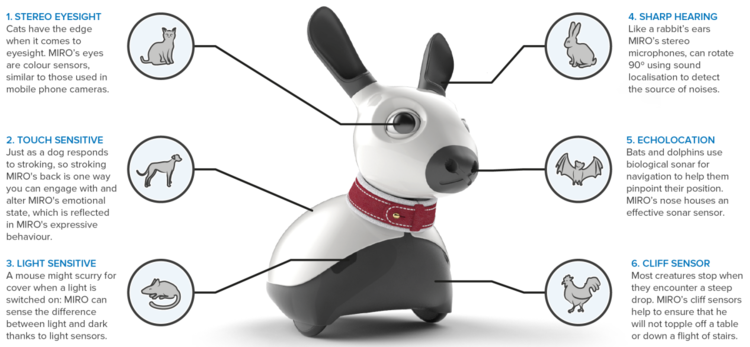We’re often asked about MiRo’s emotionally engaging design, when MiRo users are stroking its head and gazing adoringly at MiRo as it looks up at them with its big puppy dog eyes. Creating a robotic device that is emotionally engaging was a key component to MiRo’s design. Here, Consequential Robotics co-founder and product designer Sebastian Conran talks us through the engineering of MiRo’s user-experience.
Building on thirty years of experience in commercial design, and working with our design partners at SCA, we have created both the character and personality of MiRo, as well as its functional behaviour, with emotional engagement as our primary goal.
We take inspiration from animal companions given the evidence that interacting with pet animals can be spiritually enriching and can reduce feelings of loneliness. The majority of people talk to their pets - although there is little evidence that they understand humans. Indeed, we might well be disturbed if our pets spoke back. Instead of speaking to us, MiRo uses animal-like sounds and non-verbal communication, responding particularly to physical contact and touch. We are also building richer channels for animal-like communication including the ability to sense and react to the user's emotional state. Our aim is to engender quasi-sentient behaviour in response to the user’s verbal and physical input, with MiRo's body language and sound signaling its mood from playful and curious to sympathetic or sleepy.
MiRo’s character and form was carefully considered so that it is friendly and approachable, but not toy-like.
Robots that imitate nature too closely can be perceived as uncanny or threatening. Our approach has been to develop forms that abstract from nature rather than trying to replicate it, taking cues from the positioning of the eyes, nose and mouth as well as from the articulation of body parts.
Examples of products that have successfully used simplified animal forms include Miffy the rabbit, Mickey Mouse, as well as our MiRo robot. The enduring ‘cuteness’ of these simple forms, that are geometrically derived from natural shapes, means that they seem familiar and friendly. In contrast, a robot that is too close to a real mouse or rabbit could seem disturbing.
Looking at the Volkswagen Beetle, a design that may have inspired the new, friendly-looking Google autonomous car, we can see that a more abstract design can also signal “cuteness” while implying technological sophistication and trustworthiness.
MiRo is an biomimetic companion robot designed with an advanced brain to learn from its surroundings and develop a unique personality.
We have learned much from people’s reactions to the MiRo developer platform about how to create a compelling trans-generational appeal. Children interact with kittens, puppies and iPads as do older generations. To make MiRo equally versatile it needs to adapt to the user, so we are working on creating more nuanced forms of behaviour for adults and more direct ones for small children.
Usability and usefulness are also important considerations, especially for things that appear to have no obvious purpose such as robotic pets. This includes ease of use, for instance, the ability to configure MiRo using a smartphone app. As the design of MiRo evolves, we intend that it will become more modular and user serviceable, with swappable mechanical components and a snap-on cover, so that it can be easily maintained and upgraded by makers and researchers.
Like many a house cat, the future version of MiRo will likely spend much of its time ‘snoozing’ on its solar powered rechargeable charging mat, ensuring that it is ready to spring into action, and be friendly and engaging, as soon as its owner appears.
Post author
Sebastian Conran, Co-founder and Product Designer, Consequential Robotics




